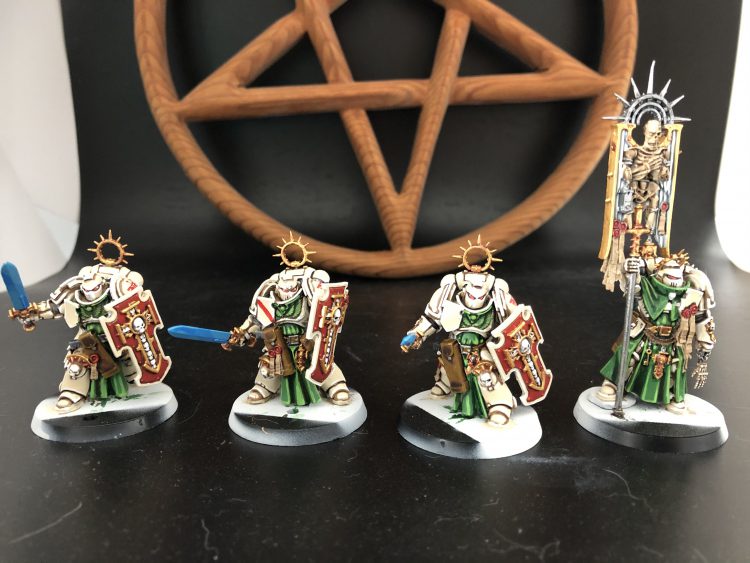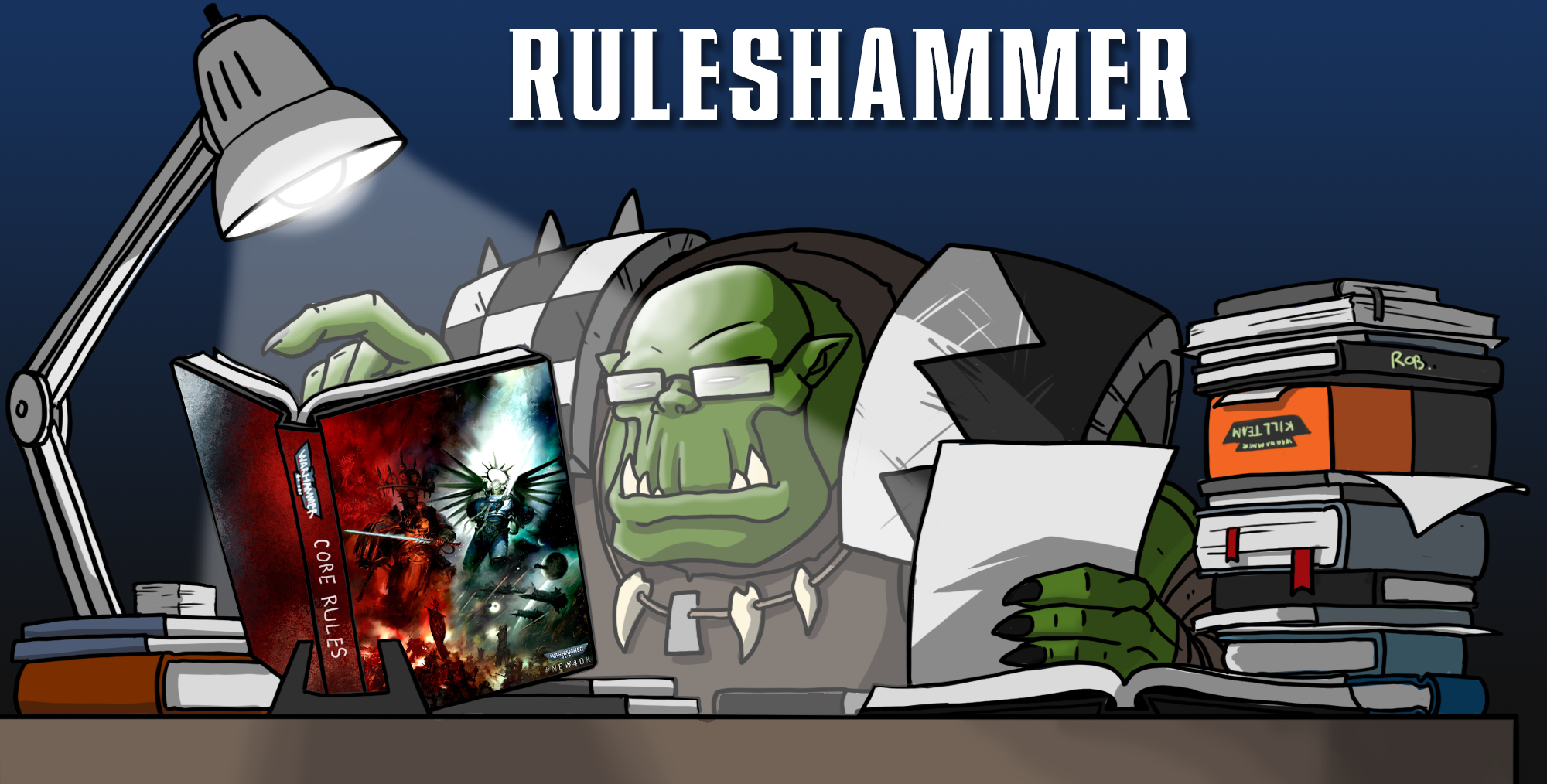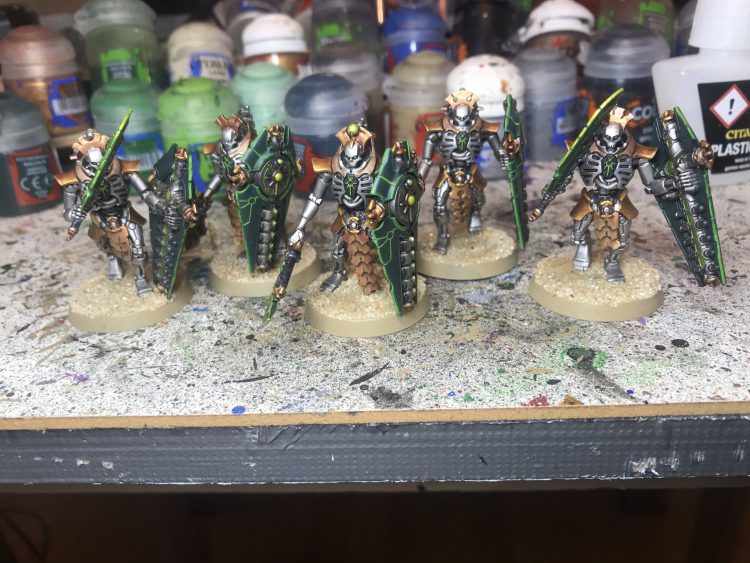This week I won’t be addressing specific questions but instead I’m going to take a bit of a delve into three areas of the rules that have come up a lot in relation to a lot of the game’s current issues.
Determining if an Ability is an Aura
So what’s an aura? This one is a bit less obvious than you might think, even in 9th edition books. The first thing to note is that the definition of an aura in the Core Rules is not “abilities that include the (Aura) tag.” If this were the definition of an aura, then none of the 8th edition rulebooks would have auras in them, and they’d need individual errata updates to add the (Aura) tag – which hasn’t happened – and abilities like Contagions wouldn’t need additional text clarifying that they aren’t auras, which also wasn’t the case. Let’s look at the definition of an Aura in 9th edition:
Aura Abilities
Some abilities affect models or units in a given range – these are aura abilities. A model with an aura ability is always within range of its effect. The effects of multiple, identically named aura abilities are not cumulative (i.e. if a unit is within range of two models with the same aura ability, that aura ability only applies to the unit once). [Core Rules PDF Pg7]
This doesn’t mention abilities tagged as Auras – that’s a convenience being added to 9th edition books, but some abilities have already been missed by this despite being auras. Do I wish this explanation was longer? Yes. Do I wish there were some examples? Absolutely. Is this mostly sufficient for us to determine what rules are auras from those that aren’t? Yes.
So really it’s just the first sentence that actually explains what an aura is. This broader definition of Auras has several implications, such as the aforementioned need to specify that Death Guard contagions are not auras:
Note, that while similar in many regards to Aura abilities, Contagion abilities are not affected by abilities that affect Aura abilities, and vice-versa.
Alright, let’s go through some examples.
Table of Contents
From 9th Edition Books
Despite many Aura abilities in 9th edition having the [Aura] tag, there are some that did not receive the tag, but are still Aura abilities.
“Bodyguard” Abilities: Is an Aura
Bodyguard abilities went through a lot of changes throughout 8th and are being replaced by an entirely new mechanic in 9th edition rulebooks. I’ve gone over how it works a few times but addressing specifically today if this ability is an aura, the answer is: Yes.
Space Marines – Bodyguard: While a friendly <CHAPTER> CHARACTER unit that has a Wounds characteristic of 9 or less is within 3″ of this unit, enemy models cannot target that CHARACTER unit with ranged attacks.
Necrons – Guardian Protocols (Aura): While a friendly <DYNASTY> INFANTRY NOBLE or DYNASTIC AGENT INFANTRY NOBLE unit is within 3” of this unit, enemy units cannot target that unit with ranged weapons.
Death Guard – Bodyguard (Aura): While a friendly <CHAPTER> CHARACTER unit that has a Wounds characteristic of 9 or less is within 3″ of this unit, enemy models cannot target that CHARACTER unit with ranged attacks.
The keen-eyed of you may have noticed that the Space Marine codex is missing the tag here – however that does not change that the ability is an Aura. Going back to the definition the effect they have on a character unit in range is that they prevent them from being targeted. The (Aura) tag is a helpful reminder, but not the defining trait.
Obeisance Generators: Not an Aura
Some very aura-like abilities are in fact, not auras. This rule is one of the more subtle non-auras released so far:
Obeisance Generators: At the start of the Fight phase, if there any enemy units within Engagement Range of Szarekh, then until the end of the phase, those units cannot fight until after all other eligible units from your army have done so.
At face value it has some of the key features of an aura – it has a range, it’s an ability. Where it differs though is that it doesn’t ONLY affect units in range, they continue to be affected until the end of the phase even if during that phase they are no longer “in range”. This persistent effect is why it is not an aura, the Silent King could die or move away from some units (if there was a unit closer) via Pile in or Consolidate and the units affected by this ability would continue to feel its effects until the end of the phase.

Some abilities affect units outside a specific range rather than inside a specific range. These are also not auras.
Omni Scramblers: Not an Aura
Omni Scramblers: Enemy units that are set up on the battlefield as reinforcements cannot be set up within 12″ of this unit.
This is perhaps one of the abilities that is most frequently mistaken for an aura. The key distinguishing feature here is that if a unit cannot be set up within 12”, then it’s being affected by this ability when it is outside 12”. This does not meet the aura definition of abilities that affect units “in a range”. Omni Scramblers affect every unit not on the board yet; that’s not units in a specified range.
Raven Guard Shadow Masters: Not an Aura
Shadow masters is not an aura for the exact same reasons as Omni Scramblers – it affects all units outside a range. However I felt it worth mentioning here because of how aura-extending abilities would affect it if they applied. Increasing the range of Omni Scramblers – if it were allowed – would provide a large benefit, forcing the opponent to deploy even further away. In a more humorous turn, increasing the range of the Shadow Masters ability would instead be a significant decrease in benefits:
Shadow Masters: Each time a ranged attack is made against a unit with this tactic, if the attacker is more than 18″ away, then the unit with this tactic is treated as having the benefits of light cover against that attack.
Each time a ranged attack is made against an INFANTRY unit with this tactic that is entirely on or within a terrain feature, if the attacker is more than 12″ away, then the unit with this tactic is treated as having the benefits of dense cover against that attack.
If this ability was an aura, then increasing the ranges mentioned by say, 6” would mean Raven Guard units only got their first effect against enemy units 24” away rather than 18”, making the ability worse – the enemy wouldn’t need to get as close to turn off the benefits of this ability.
From 8th Edition Books

For the Greater Good: Is an Aura
Each time an enemy unit declares a charge against this unit, this unit can fire Overwatch before the charge roll is made.
While a friendly unit with this ability is within 6″ of this unit, each time an enemy unit declares a charge against this unit, that friendly unit can fire Overwatch before the charge roll is made. If it does so, until the end of the phase, that friendly unit cannot fire Overwatch again.
This is a weird one, but it’s the second part of this ability is the section that meets the definition of an Aura. It’s essentially a single ability with two effects. What I haven’t been able to find in the current rules is any example of an ability combines an aura and a non-aura affect into the same rule. However, as any part of this ability meets the definition it should be treated as an aura. This has knock-on effects, as abilities that prevent units from using auras abilities would then arguably disable both parts, despite the first part not being an aura effect. Yeah, it’s a bit of a mess.
Opinion: As a Tau player myself I would still treat the whole thing as an aura and just accept that if it’s disabled then my units also lose the ability to fire overwatch without the overwatch stratagem.
Waaagh!: Not an Aura
Friendly <CLAN> INFANTRY units within 6″ of this model at the start of the Charge phase can charge even if they Advanced this turn.
This is a nice, simple, clear one – affects units in a range, giving us a nice, straightforward aura. Sorry. On a second read this is in fact not an aura. The effect is actually persistent, even if the unit with Waaagh moves away it continues to affect the units that were within 6″ at the start of the charge phase. Trust Orks to have a sneaky one.
Alpha Legion: Hidden in Plain Sight: Not an Aura
Hidden in Plain Sight: Your opponent must subtract 1 from hit rolls that target units with this trait if they are more than 12″ away.
I’ve included this one because it is essentially the same as part of the Raven Guard chapter tactic, but from a 8th edition codex. As with the Raven Guard ability, it affects all models outside its range (12”) rather than units in its range, which means it is not an aura.

Auras in 9th Edition books that are missing the (Aura) tag (that I’m aware of)
This list is not exhaustive – Bodyguard in Codex: Space Marines is the prime example of this but there are others. If you think you’ve found another example in a 9th edition book but you’re not sure, please feel free to submit it to the Ruleshammer form.
Dark Angels
Feast of Malediction: While a friendly DARK ANGELS CORE unit is within 6″ of this PRIEST, add 1 to the Attacks characteristic of models in that unit.
This is a litany that a DA Chaplain can gain via the Cup of Retribution relic, and it meets all the criteria of an Aura. Units in a range are affected.
Reliquary of the Repentant: Ravenwing Biker model only. While an enemy unit is within 3” of the bearer, each time an invulnerable save is made for a model in that unit that has an invulnerable save of 4+ or better, the saving throw is only successful on an unmodified roll of 5+.
This wording on this ability changed between the Dark Angels Index and the Codex Supplement; the original wording had the (Aura) tag. Despite losing that tag, the ability still meets all the requirements for being an Aura, and as such, is an Aura.
Have any questions or feedback? Got a rules question you want answered? Drop us a note in the comments below, ask a question in our Ruleshammer form, or head over to r/ruleshammer to discuss.




